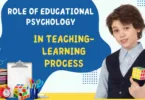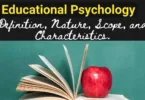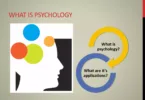What is Classroom Management?
Classroom management is crucial to create a conducive environment for learning in education. Students and teachers must develop strategies and techniques that support discipline, promote engagement, and foster positive relationships. By establishing clear rules, expectations, and routines, teachers can create a structured learning environment where students feel safe, motivated, and ready to participate actively in their education.
Top 3 Best Principles of Outstanding Classroom Management
1. Establishing rules and expectations
Establishing clear rules and expectations at the start of the classroom is one of the fundamental components of classroom management. Involving students in the rule-making process, they develop a sense of ownership and responsibility for their actions, providing them with a framework for appropriate behavior. An inclusive and open-minded classroom culture can be promoted by a classroom rule such as “Respect others’ opinions.”
- An individual’s behavior can be structured through rules and expectations.
- Student involvement in rule-making promotes ownership and responsibility.
2. Building Positive Relationships
When students feel respected, supported, and valued, they are more likely to be motivated and engaged in learning. Effective classroom management begins with positive relationships between teachers and students. Teachers can form these relationships by showing genuine interest in their students’ lives, recognizing their achievements, and providing encouragement. Learning students’ interests and aspirations might be accomplished by talking with them a few minutes each day.
- A positive relationship motivates and engages students.
- Relationships are built when students feel that you are genuinely interested in them.
3. Creating a structured learning environment
A structured learning environment helps students understand expectations and promote a sense of security. Teachers may arrange their classrooms to facilitate learning and minimize distractions. An effective classroom layout includes furniture arrangement, visual aids, and designated areas for various activities. It is easier for students to concentrate on their studies and access the necessary resources if the space is visually appealing and organized.
- Structured environments reduce distractions and improve concentration.
- Classroom layout and organization facilitate learning.
4 Best Strategies for Effective Classroom Management
- Classroom Organization and Layout
To know about Expert Classroom management, Teachers must arrange desks, seating areas, and other physical elements of a classroom to encourage student engagement and control student behavior. To promote interaction and collaboration while allowing for easy movement. For example, arranging desks in clusters or circles can foster group work and discussions.
- Classroom layout should promote interaction and collaboration.
- Group seating arrangements encourage communication and teamwork.
- Classroom Routines and Procedures
Students can develop a sense of predictability and stability if subjected to consistent routines and procedures during the school year. The clarity of expectations regarding transitions, classroom materials, and daily schedules reduces confusion and helps create a productive learning environment in the classroom. For example, a teacher might start every class with a short warm-up activity to get students involved and set a positive tone for the course.
- Routines and procedures create a predictable learning environment.
- Consistent expectations reduce confusion and enhance productivity.
- Engagement and active learning
Effective classroom management can be achieved by engaging students actively in the learning process. Teachers can implement interactive strategies to stimulate students’ interest and critical thinking, including group work, discussions, hands-on activities, and technology integration. Students’ attention and focus can be captured and maintained throughout a lesson if teachers provide opportunities for active participation.
- Active learning strategies promote student engagement.
- Hands-on activities and discussions foster critical thinking.
- Positive behavior reinforcement
Recognizing and reinforcing positive behavior is an essential aspect of classroom management. Praising students for their efforts, achievements, and adherence to classroom expectations encourages them to exhibit desirable behavior. Additionally, implementing a system of rewards, such as stickers or points, can motivate students to participate and follow the rules actively.
- Positive reinforcement encourages desirable behavior.
- Rewards and praise motivate students to engage positively
Overcoming Challenges in Classroom Management
Dealing with disruptive behavior
Disruptive behavior can be a significant challenge in classroom management. Teachers must establish clear misbehavior consequences while addressing the root causes behind such conduct. Teachers can understand their needs, provide guidance, and help them make better choices by engaging in open and honest conversations with students. Additionally, implementing classroom strategies such as “take a break” areas or behavior contracts can provide a structured approach to managing disruptive behavior.
- Addressing disruptive behavior requires clear consequences and support.
- Open communication helps teachers understand students’ needs.
Addressing diverse needs and learning styles
Classroom management should accommodate the diversity of students by providing differentiated instruction and inclusive practices to cater to their individual needs and learning styles. To ensure that all students can participate and access the curriculum, teachers can incorporate various teaching methods, visual aids, and hands-on activities.
- Differentiated instruction accommodates diverse needs.
- Inclusive practices promote equal opportunities for all students.
Managing time effectively
Time management is crucial for maintaining a productive and efficient learning environment. Teachers should plan lessons and activities to maximize instructional time while allowing for necessary transitions. Clear communication of expectations and time limits helps students stay focused and complete tasks within given timeframes.
- Effective time management optimizes instructional time.
- Clear communication of expectations enhances productivity.
Promoting inclusivity and diversity
In a diverse classroom, promoting inclusivity and celebrating differences is essential. Teachers should create a safe space where students feel respected and valued for their unique identities and backgrounds. It is possible to foster a sense of belonging and mutual respect among students by incorporating diverse resources, literature, and cultural celebrations.
- Inclusive classrooms value and celebrate diversity.
- Diverse resources and cultural celebrations enhance inclusivity.
Collaboration between Teachers, Students, and Parents
Open communication channels
Effective classroom management means Effective Teaching, and it involves open and transparent communication channels among teachers, parents, and students. Teachers could establish regular communication channels, such as parent-teacher conferences, newsletters, and online platforms, to keep parents informed about their child’s progress and any classroom updates. This collaboration allows for mutual support and reinforces consistent expectations across various settings.
- Open communication fosters collaboration and support.
- Regular updates keep parents involved in their child’s education.
Involving parents in the learning process
Engaging parents in their child’s education creates a strong partnership between home and school. Teachers can involve parents by sharing resources, suggesting activities for reinforcement at home, and inviting them to participate in classroom events. This involvement helps students feel supported, encourages parental understanding of classroom expectations, and reinforces the value of education.
- Parent involvement strengthens the home-school partnership.
- Sharing resources and activities promotes student success.
Encouraging Student Participation and Autonomy
Empowering students to participate in learning activities is vital for effective classroom management. Teachers should provide opportunities for student choice, decision-making, and independent work. Teachers promote a sense of ownership and autonomy by encouraging participation and allowing students to have a voice in their education, leading to increased engagement and motivation.
- Student participation and autonomy foster ownership and motivation.
- Allowing student choice promotes engagement.
Summary
Effective classroom management is crucial to creating an optimal learning environment. A teacher can create an environment where students thrive academically, socially, and emotionally by understanding the principles of classroom management, implementing strategies to engage students, overcoming challenges, and fostering collaboration. Teachers can ensure that every student can achieve their full potential by creating an inclusive, structured, and positive classroom atmosphere.
FAQs (Frequently Asked Questions)
What is classroom management, and why is it important?
Classroom management adopts teachers’ strategies and techniques to create a productive and positive learning environment. It establishes and maintains a structured atmosphere where students can engage in meaningful learning activities. Effective classroom management is important because it helps promote student engagement, reduces disruptive behavior, and maximizes instructional time, thus facilitating optimal learning outcomes.
How can effective classroom management enhance student learning?
Effective classroom management enhances student learning by creating an environment conducive to academic growth. When classroom rules, expectations, and procedures are clear and consistently enforced, students feel secure and are more likely to participate in lessons actively. Well-managed classrooms minimize distractions, provide collaboration and individualized support opportunities, and foster positive teacher-student relationships, all promoting student engagement and academic achievement.
What are key strategies for establishing classroom rules and expectations?
Students must be involved in establishing rules and expectations in the classroom to foster ownership and understanding. Teachers should explain the rationale behind every direction, provide examples for clarification, and set clear and concise rules that align with respect, responsibility, and safety. Maintaining a respectful classroom environment also involves establishing consistent consequences for both positive and negative behavior.
How can teachers create a positibve and inclusive classroom environment?
Teachers can create a positive and inclusive classroom environment by promoting belonging and valuing diversity. This can be achieved through various strategies, such as fostering positive relationships with students, recognizing and celebrating individual strengths and achievements, promoting collaboration and teamwork, and integrating culturally responsive teaching practices. Creating a safe and accepting classroom climate where all students feel respected and valued enhances their engagement, motivation, and well-being.
What are some effective techniques for managing student behavior?
Effective techniques for student behavior are establishing clear routines and procedures, providing explicit instructions and expectations, using positive reinforcement and rewards for desired behavior, implementing consistent consequences for misbehavior, using proactive strategies like proximity control and non-verbal cues to redirect off-task behavior, and implementing strategies to address individual student needs, such as differentiated instruction and behavior intervention plans.
How can teachers effectively communicate expectations and instructions to students?
Teachers should use clear and concise language to effectively communicate expectations and instructions, provide visual aids or written prompts to support comprehension, model desired behavior or task completion, and allow opportunities for questions and clarification. Using a variety of instructional strategies, such as visual cues, gestures, and demonstrations, can help cater to diverse learning styles and ensure that students understand and can follow instructions effectively.
What role does classroom organization play in effective classroom management?
As We have learned in Discovery Learning, Classroom organization is vital in effective classroom management as it contributes to a structured and efficient learning environment. Organizing physical space, instructional materials, and resources in a logical and accessible manner helps minimize distractions and maximizes instructional time. Well-organized classrooms also support smooth transitions between activities, facilitate student movement, and promote a sense of order and predictability, which is essential for maintaining a focused and productive learning environment.
How can teachers handle disruptions and maintain a productive learning environment?
Teachers can handle disruptions and maintain a productive learning environment using proactive strategies and responsive techniques. Proactive strategies include setting clear expectations, establishing positive student relationships, and implementing preventive measures, such as engaging in lessons and activities. Responsive methods involve promptly addressing disruptions, using clear and assertive communication, redirecting or reminders, and utilizing appropriate consequences when necessary. Consistency and fairness are crucial in managing disorders effectively.
What are some strategies for addressing diverse student needs in classroom management?
Strategies for addressing diverse student needs in classroom management include differentiating instruction to accommodate varying learning styles and abilities, implementing individualized behavior plans for students with specific needs, fostering a culturally responsive classroom environment that values and respects diverse backgrounds, providing appropriate support and accommodations for students with disabilities or language barriers, and promoting inclusive practices that embrace the strengths and interests of all learners.







[…] key aspect of effective classroom management is establishing clear behavior and academic performance expectations. Elementary teachers must […]
[…] Classroom management constitutes a fundamental element in attaining positive educational outcomes. Organizational and behavioral management within the classroom provides students with the necessary structure that enhances the learning process. While this is particularly crucial in elementary school classrooms, the same principles can be applied to middle and high school students. Six key components of classroom management exist, each capable of transforming a chaotic classroom into an environment conducive to learning. […]
[…] Classroom behavior management refers to a broad array of techniques that educators use to ensure cooperative student behavior. Effective behavior management strategies can help create an environment conducive to learning, foster a positive classroom climate, and build students’ self-esteem. […]
[…] classroom management consequences of collaboration are significant. Instructors should provide an environment that […]
[…] discussed the process of implementing innovative teaching strategies, offering a step-by-step guide, addressing challenges, and showcasing real-life case studies demonstrating successful […]
[…] classroom management is essential for creating a conducive learning environment that promotes student engagement, […]
[…] on the relationship between teaching and learning. It explores effective instructional strategies, classroom management techniques, and educational interventions that optimize student learning outcomes and promote […]
[…] educational psychology empowers educators to adopt a proactive approach to classroom management, fostering a positive and conducive learning environment. Leveraging principles of behavior […]